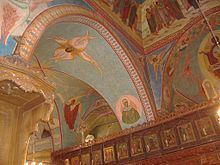Opened 432 AD Year consecrated 432 AD | Ecclesiastical or organizational status Active | |
 | ||
Affiliation Antiochian Orthodox Church Similar Monastery of St Elian, Saint Mary Church of the Holy, Great Mosque of al‑Nuri, Khalid ibn al‑Walid Stadium, Khalid ibn al‑Walid Mosque | ||
The Church of Saint Elian (Arabic: كنيسة مار اليان, Kaneesat Mar Elian) is a church in Homs, Syria, located along Tarafa bin al-Abd Street near the Gate of Palmyra. The Feast of St. Elian is held annually at the church on February 6 and attracts a large number of pilgrims.
History
The church is named after Saint Elian, a native of Emesa (now Homs), who was martyred for his refusal to renounce Christianity in 284 AD at the hands of his father, a Roman officer. St. Elian was a physician by trade and various miracles of healing are attributed to him. The church itself was founded in 432 on the claimed spot of St. Elian's death, with his remains placed in a sarcophagus in a small chapel to the right of the church's main crypt.
In 1969–70, the church was renovated. During the renovation, the plaster which covered the inner walls of the crypt was removed, revealing ancient frescoes depicting murals of Jesus, Mary, the Apostles, and various Biblical prophets. The frescoes date to at least the 12th century, but it is widely believed to date to the 6th century, making them the oldest surviving church paintings in Syria. Today, they are complemented by new frescoes in the main nave and side-aisles of the church painted by two Romanian iconographers, showing various scenes of St. Elian's lifetime.
